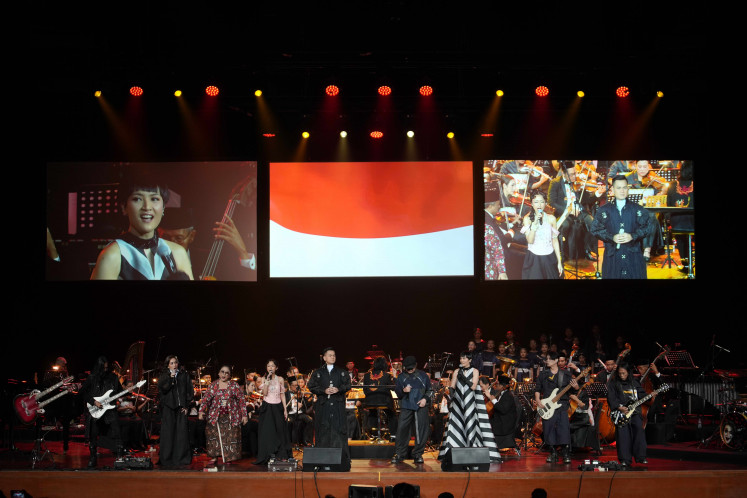Popular Reads
Top Results
Can't find what you're looking for?
View all search resultsPopular Reads
Top Results
Can't find what you're looking for?
View all search results'I'm A Ghost in My Own House' shortlisted for art prize
Choe U-Ramâs Custos Cavum (Guardian of the hole)
Change text size
Gift Premium Articles
to Anyone
Choe U-Ram's Custos Cavum (Guardian of the hole). JP/Stevie Emilia
An intense and powerful 12-hour performance titled I'm a Ghost in My Own House by renowned Indonesian artist Melati Suryodarmo has been shortlisted as one of the 15 finalists vying for a prestigious contemporary art award.
Her performance is among 15 works coming from 13 countries nominated for the Asia Pacific Breweries (APB) Foundation Signature Art Prize 2014.
First introduced in 2008, the prize is awarded to artwork from the region that represents significant developments in the Asia-Pacific's contemporary art landscape.
The finalists' works ' all offer a glimpse of the region's rich and constantly evolving contemporary art scene ' are on display at the Singapore Art Museum (SAM) at an exhibition that runs until March 15 next year. The prize winners will be announced at an awards ceremony on Jan. 22, 2015.
Melati said her performance, created in 2012 and nominated by curator Rifky Effendy for the prize, was based on her research and personal experiences on the meaning of 'home' and the feeling of loss, of
being homeless.
'Sometimes, even when we're at home, we don't feel like being at home. I think this is a common phenomenon experienced by many other people,' the 45-year-old artist, who spends her time between
her home in Surakarta, Central Java and Germany, explained at the exhibition.
'It's like a ghost; we think it is there but we can't see it. It represents my feeling, constantly questioning: what am I; who am I?'
Charcoal is an essential material for Melati's performance and installation, recreated at the museum with more than 150 kilograms of it. Prevalent as a source of fuel, especially in Southeast Asian countries, it is made by cooking wood in a low-oxygen environment to evaporate all water out of it and harden it.
Task of transformation: Artist Melati Suryodarmo explains her piece, titled I'm a Ghost in My Own House, on display at the Singapore Art Museum in Singapore. JP/Stevie Emilia
As a material, charcoal is life-sustaining because it provides heat and fire ' yet it also has the capacity to burn and destroy.
In this poetic performance, for 12 hours, Melati crushed hundreds of charcoal briquettes on a grinding table, putting all her energy into turning the material to dust ' actions that strip charcoal of its potential energy, causing it to lose its efficacy and function.
Melati said the process of creating charcoal from wood harvested from trees and then rendering this to dust can be paralleled with the experience of a person undergoing a psychological metamorphosis ' in which thoughts and excesses are purged, pulverized and incinerated, to the extent that their very
structures are transformed from what they were before.
'The time frame, 12 hours, is significant for showing how humans understand the period of one day, when there's 12 hours each of day and night,' said the artist, who also studied under renowned Butoh dancer Anzu Furukawa and acclaimed performance artist Marina Abramovic and had taken part in many events, locally and abroad, including the Venice Biennale Dance Festival.
'Within one of these periods the body rests, while the other is spent in the rhythms and rituals of daily life that include eating, moving and working.'
The prize's other finalists ' chosen out of 105 nominated artworks from 24 countries by a panel of judges consisting of prominent art experts ' come from Australia, Bangladesh, China, India, Japan, New Zealand, Pakistan, Singapore, South Korea, Taiwan, Thailand and Vietnam.
Arin Rungjang's Golden Teardrop. Courtesy of Singapore Art Museum
Arin Rungjang's monumental Golden Teardrop brings heavy, ancient beams from an old Ayutthaya house and iron trusses from a post-war factory into the museum gallery. Together, these structures frame a delicate sculptural object made up of almost 6,000 drops referred to in the work's title.
Meanwhile, Korean artist Choe U-Ram's fantastical metallic creature ' at once robotic and chimerical ' Custos Cavum (Guardian of the hole), which seems to move and breathe, lies at the heart of the museum.
Vietnamese artist Nguyen Trinh Thi's Unsubtitled video projection on wood cut-outs greets visitors with low murmurings and the chewing and swallowing of soft food in a darkened space in which loom life-size projections of 19 people.
Unsubtitled by Nguyen Trinh Thi. Courtesy of Singapore Art Museum
She said she documented these artists, curators, writers and key figures from the independent contemporary art scene in her home in Hanoi as her way of investigating the history and development of the place and the role of artists in
society.
'I invited the artists, 19 of them, and asked them to choose the food they wanted to eat. They then identify their names and the food they had just consumed,' she explained.
The work is a haunting testimony to the enduring yet fragile condition of freedom expression.
'I want to represent the common situation faced by artists in Vietnam. There's little space for them to really express themselves. They have to explain very clearly the intention or meaning [of their works]. If it's something ambiguous, it may turn tricky or even dangerous for them.'
Elsewhere at the exhibition, artists use unusual materials. For instance, Robert Zhao Renhui evokes a peculiar parable with Eskimo Wolf Trap often quoted in Sermons and recreates a snowy landscape with almost 400 KG of
bicarbonate of soda.
On top of vying for the S$60,000 Grand Prize and two $15,000 Jurors' Choice Awards, each of the 15 artworks are also in the running for a People's Choice Award worth $10,000.
Awarded to the artwork that garners the most public votes, the People's Choice Award invites the public to engage with the competition and aims to stimulate lively public discussion and critical discourse.
The public can cast their votes for their favorite finalist at the museum or via singaporeartmuseum.sg/signatureartprize from Nov. 14 to Jan. 21, 2015 and they also stand to win prizes.
A series of parallel programs including curatorial tours, educators' talks and sensory workshops have also been organized.
Singapore Art Museum Director Susie Lingham said the shortlisted works showcase creative explorations of art forms and media and are conceptually well-wrought at the same time.
She said diverse social, cultural and political issues are engagingly and accessibly expressed in these artworks, where each embodies the transformative quality of art.
'Many of the works open up to great depths ' both visually and metaphorically ' at the moment of encounter. They each, in their unique way, reveal the power of contemporary art as a meaningful experience,' Lingham says.
'Both culturally and aesthetically, we witness the rich diversity and imagination of the Asia-Pacific region.'














